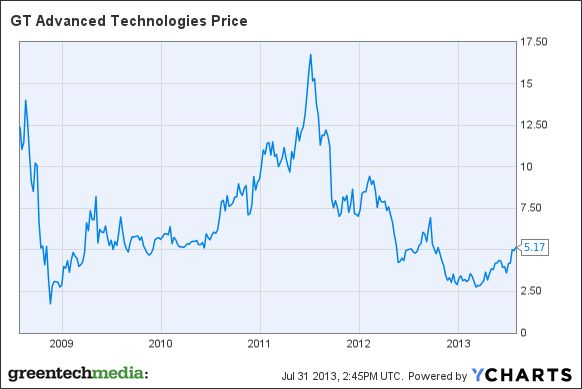GT Advanced Technologies (GTAT) might be one of the more mature solar companies that most people haven't heard of. That's because GT is an upstream solar company with technologies for polysilicon production, as well as sapphire and silicon crystal-growth systems for photovoltaics and LED lighting devices. Solar product offerings include chemical vapor deposition reactors, polysilicon processing systems, and ingot growth systems.
Like all solar manufacturing equipment vendors, the last few years have ranged from difficult to ruinous, making 2012 GT's first money-losing year since it went public in 2008. Fortunately, GT is diversified and its stock price seems to be recovering -- as its battered solar group readies itself for the global supply-demand imbalance to right itself. The company is guiding 2013 revenue in the range of $500 million to $600 million.
We spoke with Jeff Nestel-Patt of GT earlier this month. He said that GT began as a "one-trick pony" in the solar space but has since diversified into other markets through acquisition:
- GT acquired sapphire producer Crystal Systems in 2010 for LED applications.
- GT acquired Confluence Solar for $80 million in 2011 for its continuously-fed Czochralski growth process technology for high-efficiency monocrystalline solar ingot production.
- GT acquired the assets of Twin Creeks Technologies in 2012 for approximately $10 million. GT will use Twin Creeks Proton-Induced Exfoliation equipment for power semiconductors, solar wafers, and thin sapphire laminates for touch screens.
- Earlier this year, GT acquired Thermal Technology's high temperature thermal and vacuum products for fabricating advanced materials for smartphones, touch screens, LEDs, medical devices, and oil and gas and automotive applications.
Almost 90 percent of GT's business comes from Asia's polysilicon, ingot and wafer manufacturers. Its largest polysilicon customer is Korea's OCI.
Regarding imminent tariffs on polysilicon imported into China, Nestel-Patt was quoted in the Washington Post as saying, “Fortunately for GT, our largest polysilicon customer, Korea-based OCI, will have to pay only a very small 2.4 percent tariff on their polysilicon exported to China,” adding, “Though it is too early to tell, reduced levels of imported polysilicon from U.S. suppliers as a result of the tariffs could benefit producers from other countries such as OCI in Korea, who have the capacity to supply high-quality material.”
Nestel-Patt said that they had given up "to a point" on China's "intellectual property conundrum." He said that GT's strategy is to offer a next-generation platform plus local support and service.
"We are the poster child for survival of an American vendor working in China -- by not competing on price, but by competing on innovation," said Nestel-Patt.




